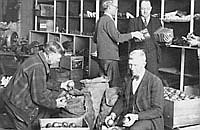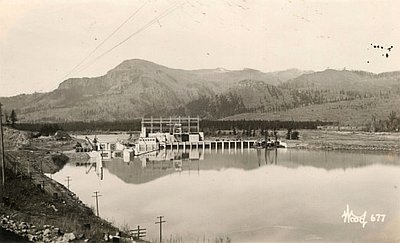Timber and Salmon
At the onset of the Progressive Era, Washington and Oregon led the nation in lumber manufacturing, and timber production was emerging as the centerpiece of the Pacific Northwest economy. The harvests along the lower Columbia River had accelerated during the 1880s and 1890s, and other parts of Oregon also contributed to the increased production of wood products, including the Powder River Valley on the far eastern edge of the state.
The completion of the Oregon Short Line through the Blue Mountains in 1884 invited speculation in the state’s timberlands, especially in the person of Utah investor David Eccles, who was looking for virgin pine timber. Through ruse and subterfuge and dummy entrymen, Eccles blocked up large acreages of timber during the 1880s. At the close of the decade, he and a group of associates incorporated the Oregon Lumber Company.
After constructing a sawmill in the small town of Baker City, Eccles built a railroad up the narrow Powder River Canyon and set in motion a harvesting, transportation, and production system that would last through World War II. Similar developments took place on the southern Oregon Coast, where Minnesota lumberman Charles Axel Smith opened a state-of-the-art mill on Coos Bay in 1908. The Mill, as it was known, was a significant player in the Pacific lumber trade and provided a boost to the region's lumber production.
Perhaps the most anticipated and celebrated of Oregon’s timber frontiers was the opening of central Oregon’s ponderosa district to production. When James J. Hill’s Great Northern Railway and Edward R. Harriman’s Union Pacific Railroad waged a battle to build a line through the Deschutes gorge in 1909, timber speculators were already at work blocking up valuable ponderosa pine stands in the forested belt between Bend and Klamath Falls. Completing the railroad to Bend, the Pacific Monthly declared, would “tap the rich Central Oregon country” and provide access to the “visible natural wealth” of its forests.
With the transportation system in place, two Great Lakes lumber firms, Shevlin-Hixon and Brooks-Scanlon, built sawmills on opposite sides of the Deschutes, upriver from Bend. Shevlin-Hixon began milling lumber from its 200,000 acres of timberland in March 1916. A month later, Brooks-Scanlon opened a facility with similar productive capacity. For more than three decades, production at the mills was restricted only by market conditions and the constraints of federal ownership of forestlands. “The history of the economic development of Deschutes County,” a U.S. Forest Service report proclaimed in the mid 1930s, “is largely the history of the lumber industry.”
Timber was also important in the Klamath and Harney basins. The extension of the Southern Pacific Railroad to Klamath Falls from the south in 1909 created a frenzy of timber speculation in the region, with the Weyerhaeuser Timber Company emerging as the dominant property holder. On the southern fringe of the extensive ponderosa-pine forests, Klamath County’s immense stands of timber grew on relatively even terrain, easily accessible by railroad and later truck-road transportation. Most of that timber was within a thirty-mile radius of the big sawmills in Klamath Falls.
The story of timber cutting in the Blue Mountains to the north of Burns is a complicated one, involving the aspirations of local people who wanted rail access to outside markets and the ambitions of the U.S. Forest Service to sell timber. In 1922, the Forest Service offered a huge volume of timber for sale in the Bear Valley with the idea that the successful bidder would build a rail line to Burns and then north to Seneca, adjacent to the forested stands. The Edward Hines Lumber Company of Chicago was the successful bidder on the project, and the big Hines mill opened outside Burns in 1930. The enormous investments in railroad construction and the company's need to meet its bonded debt meant that timber cutting far exceeded sustainable harvest practices.
On the Columbia and other Pacific Slope rivers, the great salmon runs lured entrepreneurs to the Northwest in the 1860s. In 1866, William Hume, of Hapgood, Hume, and Company, established the first fish cannery on the Columbia, at Eagle Cliff on the north bank of the lower river. The cannery produced four thousand cases of salmon that year, with forty-eight one-pound cans per case. Canned salmon was especially suitable for shipment over long distances, and the abundance of fish meant they could be priced for eastern U.S. and European markets. Within three years, other shippers began to open markets in England and in working-class areas on the East Coast. From those beginnings, the salmon business grew into a major regional industry.
From the beginning, the Columbia River salmon business was a productive enterprise. By 1883, fifty-five canneries operated on the lower river, and canneries also operated on almost all of the state’s coastal rivers. Chinese and Japanese worked in the canneries as early as 1874; and by the 1880s, with the steady decline of work on the railroads, they found steady, if seasonal, employment in the industry. In 1880, 78 percent of Astoria’s Chinese population worked in canneries. By the 1920s and 1930s, increasing numbers of Filipinos worked in canneries, since the laws restricting immigration of other Asian groups in the 1920s did not affect them.
Fishers who supplied the canneries used highly efficient harvesting techniques, including stationary fish traps, seines, gill nets, and—most impressive of all—fishwheels. Powered by the current, the stationary and scow-mounted wheels literally scooped fish from the river.
The catch for all salmon species on the Columbia reached a record high in 1911, at 49,480 pounds. The take of the more valuable Chinook salmon peaked in 1883, when 39 canneries operated on the lower Columbia. Some people began to worry about the future of the industry because of the size of the harvest.
For more than two decades, Columbia River salmon production fluctuated widely and then began a steady but appreciable decline after 1937. The legislature in Oregon and a 1934 Washington State voter initiative banned fixed-gear harvest—fishwheels, traps, seines, and set nets—with some success, eliminating 27 fishwheels and dozens of other devices. The behavior of the salmon industry paralleled similar practices in the timber industry: too many producers, unlimited entry to a seemingly limitless resource, and too much product on the market—conditions that encouraged waste and drove prices down.
A few people believed that environmental factors might explain the declining numbers of salmon. Mining operations, increasingly mechanized agricultural and logging activities, changes to riparian areas caused by grazing practices, and water diversions for irrigation affected salmon spawning habitat. Cities and towns along major streams were dumping domestic sewage and untreated industrial wastes directly into waterways. In the long run, it was the combination of those activities that proved so harmful to anadromous fishes.
Well before hydroelectric dams were built on the Columbia and other rivers in the Northwest, salmon numbers were in decline. Moreover, the many small dams in the Columbia drainage made nearly half the basin inaccessible to migrating salmon by the end of the nineteenth century. In retrospect, the “salmon crisis” of recent years is a century-old phenomenon, but its political day did not come until the 1960s, when the potential loss of salmon species became evident and was widely publicized.
© William G. Robbins, 2002. Updated and revised by OE Staff, 2014.
Sections
Related Historical Records
Threshing near Klamath Falls
This postcard shows farmers using a steam-powered thresher near Klamath Falls, which was originally called Linkville. In 1909, the Southern Pacific Railroad reached Klamath Falls, helping attract more …

Weyerhaeuser Timber Company
At the time of this photo in 1941, Weyerhaeuser Klamath Falls employed approximately 1,200 men and produced 200 million feet of wood products each year. Weyerhaeuser experienced a …

Chinese Workers in Astoria Cannery
This undated photograph of the interior of an Astoria cannery is from the Burlington Northern / Spokane Portland and Seattle Railroad Collection. This promotional photograph conveys the message …







